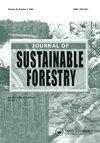Some Thoughts on Mountain Forests: Their Benefits and Sustainability
IF 1.8
4区 农林科学
Q3 FORESTRY
引用次数: 0
Abstract
Mountain forests occur on most of the continents on this planet. Definitions of what constitutes as a mountain forest can be arbitrary. A reasonable operational definition is “forests on land with an elevation of 2500 m a.s.l. or higher, irrespective of slope, or on land with an elevation of 300– 2500 m and a slope with sharp changes in elevation within a short distance” (Price et al., 2011). However, where they start and end on a particular mountain depends on its climate, soils, topography, other organisms that live in the forest, and random factors. To paraphrase the Greek philosopher Heraclitus no person climbs the same mountain twice because the mountain is not the same and the person is not the same. Mountain forests comprise about 20% of the world’s forests and provide many essential services such as preventing erosion and serving as water sheds (Price et al., 2011). Trees take up carbon dioxide (a greenhouse gas) and give off oxygen. The carbon dioxide is converted into woody tissue that sequesters the carbon and helps mitigate global warming for long periods of time. The oxygen released is required for all aerobic life. Like other forest types, mountain forests are a significant part of these processes. As I approach my nonagenarian years, I look back at 70 years of my close relationship with the mountain forests and I call for their sustainable management that can support and improve the capacity of mountain forests to provide environmental services (Gratzer & Keeton, 2017). Forests are complex systems. Each tree in a forest supports a diversity of life including insects, birds, mammals, mosses, and lichens (Körner, 2004; Perrigo et al., 2020). The complexity of a forested system is beyond what the eye can see as trees of the forest communicate both above and below ground in many ways. In the soil, the trees communicate by sharing soil resources with the help of a fungal network with the tree roots termed mycorrhizae. Above ground, the trees give off volatile compounds if they are attacked by pathogens and these stimulate neighboring trees to synthesize protective compounds like polyphenols. Some deeper-rooted trees can bring up water from great depths and exude it at shallower depths permitting other organisms to take it up. Tree roots also exude a variety of chemicals into the surrounding soil. Some of these attract beneficial soil microorganisms and create a special environment around the roots termed the rhizosphere. Other exudates given off by the roots of one species inhibit other species in a process called allelopathy. This gives a competitive advantage to the excreting species over other species in the competition for scarce resources. In the initial stage of forest formation from seedlings the tree stems are very dense, but as the forest develops the number of trees per hectare decreases as there is not enough space and resources for all the trees to grow large. This competition is especially evident at higher elevations when tree density decreases with关于山林的几点思考:它们的效益和可持续性
本文章由计算机程序翻译,如有差异,请以英文原文为准。
求助全文
约1分钟内获得全文
求助全文
来源期刊

Journal of Sustainable Forestry
Social Sciences-Geography, Planning and Development
CiteScore
3.90
自引率
12.50%
发文量
42
期刊介绍:
Journal of Sustainable Forestry publishes peer-reviewed, original research on forest science. While the emphasis is on sustainable use of forest products and services, the journal covers a wide range of topics from the underlying biology and ecology of forests to the social, economic and policy aspects of forestry. Short communications and review papers that provide a clear theoretical, conceptual or methodological contribution to the existing literature are also included in the journal.
Common topics covered in the Journal of Sustainable Forestry include:
• Ecology, management, recreation, restoration and silvicultural systems of all forest types, including urban forests
• All aspects of forest biology, including ecophysiology, entomology, pathology, genetics, tree breeding, and biotechnology
• Wood properties, forest biomass, bioenergy, and carbon sequestration
• Simulation modeling, inventory, quantitative methods, and remote sensing
• Environmental pollution, fire and climate change impacts, and adaptation and mitigation in forests
• Forest engineering, economics, human dimensions, natural resource policy, and planning
Journal of Sustainable Forestry provides an international forum for dialogue between research scientists, forest managers, economists and policy and decision makers who share the common vision of the sustainable use of natural resources.
 求助内容:
求助内容: 应助结果提醒方式:
应助结果提醒方式:


